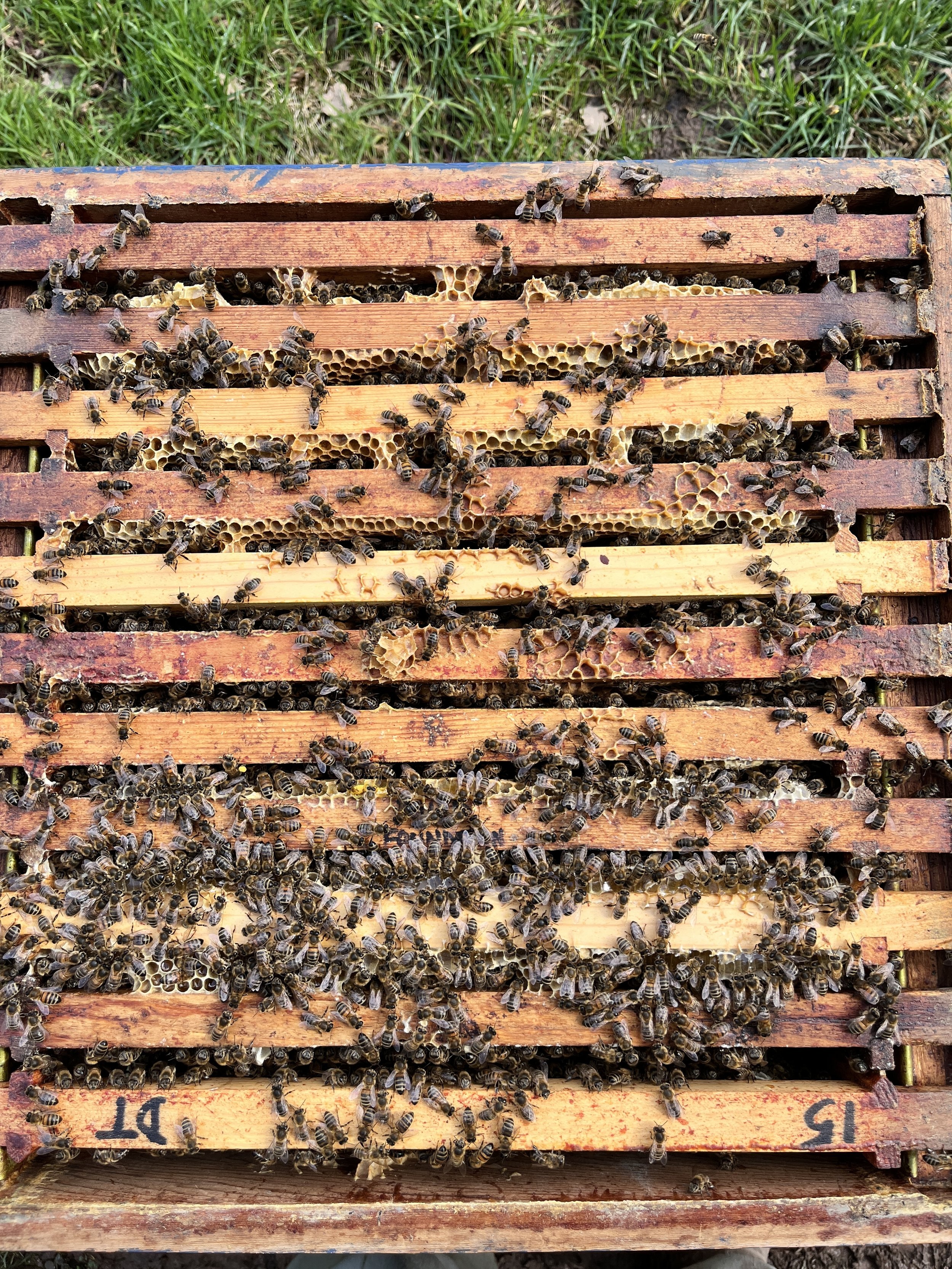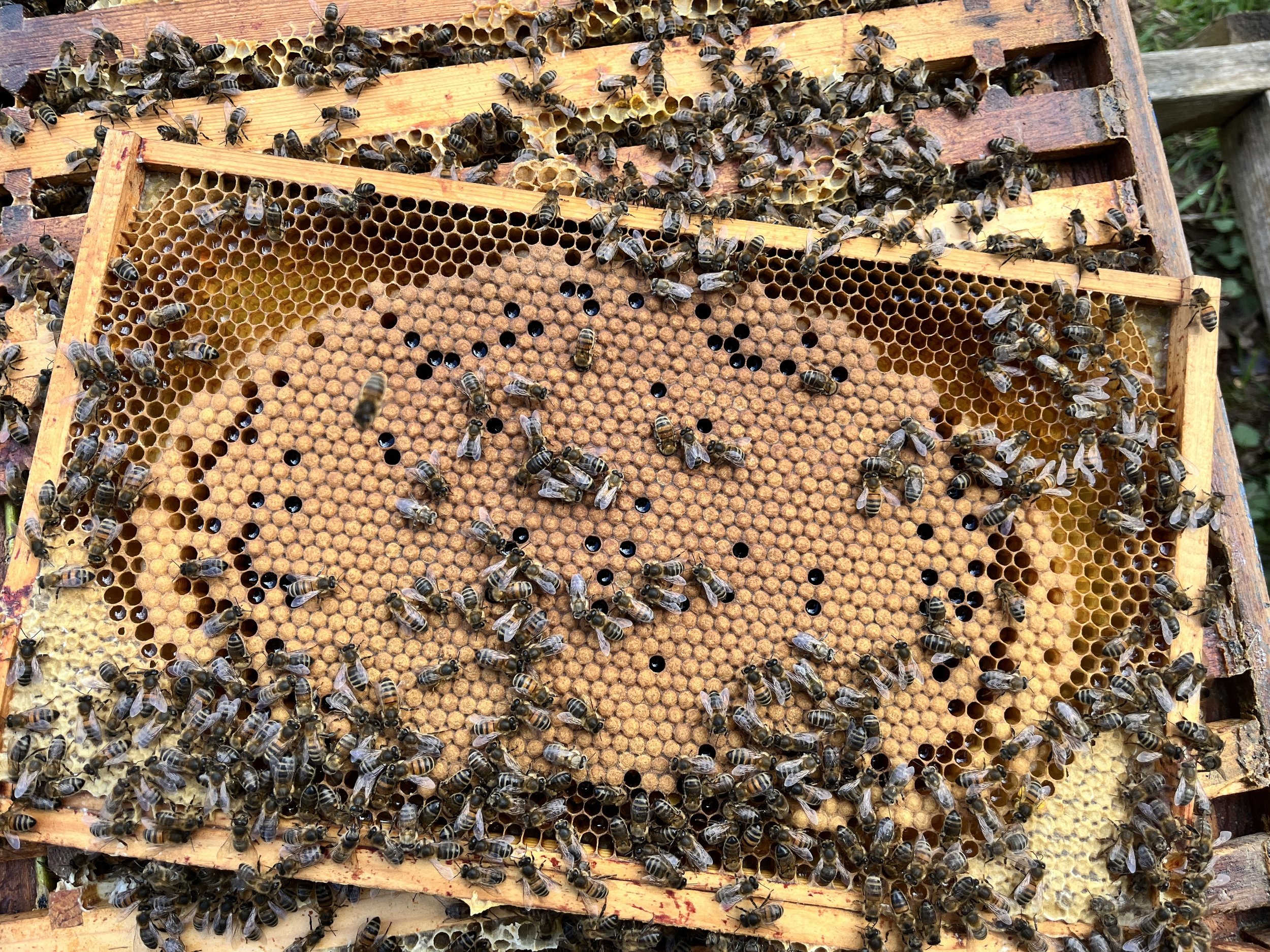AT LAST A PEEK INSIDE!
Well, the sun shone for a couple of hours and I felt it was an acceptable temperature to have a quick look in one of my hives - hive no. 1 - the one I’ve been a bit concerned about. It didn’t seem as busy as the others and I was beginning to think perhaps the queen hadn’t survived and the remaining workers were just dwindling away. How wrong was I?
Not only was she there, she even presented herself to me! Obviously she’s had a bit of a rough winter as her red dot had all but disappeared but when the weather improves I shall be sorting that out. Red dot? Yes… we mark our queens with queen marking pens - non-toxic, water-based paint pens . We put a dot, according what year she was born on her thorax. It doesn’t harm her in any way. By marking a queen it makes her easier to find and also we can tell how old she is. There are various methods of marking a queen.
You can use your fingers. For this you have to be well practiced. People who use this method have usually refined it by practicing on drones before they attempt a queen. You very delicately pick her up by her wings, (picking her up by her abdomen could damage her), and pop the dot on her thorax using the pen. It’s better to do this without gloves and if you do use gloves it’s advisable to use latex as they are thinner and less clumsy.
The queen marking cage. This looks like an instrument of torture but in fact it’s completely safe. You find the frame with the queen on, place it gently on top of the other frames and pop the cage over the queen. This traps her, and a few of the workers, and as quick as you can you mark her.
The one handed queen catcher. This is the method I use. Once you have found the queen you place the tube over her and gently close up the bottom. (Be very careful… I once crushed a queen while closing the bottom up 🤪 It only ever happened once as these disasters are want to do). She will now be sitting on top of a foam plunger which you gently push to the top. Once she is still you can then mark her. I like this method because the queen is isolated from her workers and for me that’s less faffing about!
I would advise not to mark a new queens until she has been out on her nuptial flight and started laying. I don’t want to damage her wings. As careful as you are sometimes it’s difficult to be precise and a little bit of the marker can go on her wings. It is a delicate operation no matter which method you choose.
I promise a video of me marking a queen when the weather improves.
I digressed, as I am want to do! The sun stayed out longer than I anticipated and so I decided to take the plunge and see what had been going on in the other four hives. To my delight they are all queen-right and increasing in size. The images below are from hive no. 5… surely you know by now this was my naughty/difficult hive. The one where they wouldn’t accept a queen. Well they did in the end and it’s turned out to be the strongest of them all so they were obviously waiting for the right queen to come along. I shall call this hive the fussy hive from herein! All the frames on hive no. 5 were covered in bees. By the time I took this picture a lot of them had gone down and look at the beautiful rugby ball shape of the brood she is laying. (This was on both sides by the way). I didn’t go any further. I quickly closed up the hive and left them to it, as I did with all the hives. As soon as I saw evidence of laying I put the hives back together. Plenty of time to take my time when the weather improves.
The good thing about doing this inspection is that I now know that in In four of them I will have to to a Bailey Comb Change and next time I go to the apiary I will be ready and prepared.
I’ll go through with you when I do it and I will try my best to produce a video of it happening!
Comb in a beehive has to be replaced every three years because as comb gets older it gets damaged and smaller and will therefore produce smaller bees and, most importantly, used comb may contain bee diseases such as such as EFB - European Foul Brood. AFB - American Foul Brood and Nosema - a form of bee dysentry.
There are two methods of changing comb that I’m aware of. One is the Bailey Comb Change and the other the Shook Swarm method. The shook swarm should only be done with a strong colony and when the weather is guaranteed to be good for a week. The aim is to move the whole colony of bees into a new brood box of foundation and destroy the old combs including the brood.. It is the most effective way of removing disease from a hive but I did it once and found it a bit radical.
Well that’s it for this week. Nice to have some news about my bees for a change!
I will leave you with this lovely photograph I took of a bee flying towards cherry blossom. I was in the South East for the Easter break and I came upon this incredible Cherry Tree which was actually humming with bees and the fragrance from the blossom was absolutely beautiful. The south is obviously way ahead of us here in Herefordshire weather-wise. As I type this blog, I’m sorry to say the rain is pouring down again and they dare to say in the papers we may be facing a water shortage this summer. Errr… how come?
Oh well, at least my bees are ok…she says smugly.
My quote of the week, seems appropriate given the beautiful cherry tree I discovered in Flaunden…
“the hum of bees is the voice of the garden’
(Elizabeth Lawrence)
… it sure is!
Have a wonderful week… and remember to share this blog if you can!

